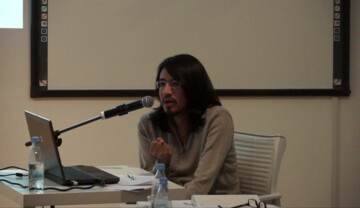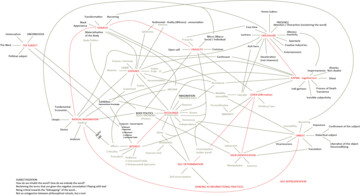“Transvestite: Aberrant, effeminate, abnormal, stray, degenerate, common criminal, highly dangerous criminal, criminal dressed as a woman, shameless, sexual deviant, dressed up, drag queen, anti-social, entity of HIV transmission, scandalous, fake woman, gay, stray gay, gay with a miniskirt, thug, tea-leaf, man dressed as a woman, man in feminine clothing, homosexual, stray homosexual, homosexual dressed as a woman, un-desirable, strange individual, immoral, inverted, gossip, social evil, crazy, crazy street hag, unlawful, scumbag, illegitimate, queer, faggot, fag, erotic minority, pedophile, passive pederast, person of questionable conduct, personality, character, antisocial character, lowlife character, pervert, weird, weirdo, ambiguous being, marginalized being, snitch, third gender, transgender, transformer, transvestite, vulnerable (still under construction). . .” Terms used by the local press to refer to trans people collected by drag activist Giuseppe Campuzano
Travesti [transvestite] is a popular word in Latin American that means drag. Usually refers to the person who cross-dress his body rejecting any natural or essential identity order. Transgender community has been largely marginalized and rendered invisible to most mainstream communities, and it is still the most vulnerable people in most of the Latin American countries.
The transvestite makes visible the workings of gender, revealing its contingency as well as the performative possibilities of challenging gendered norms. Transvestite performance highlights how bodies are discursively produced and how identity is never fixed, emphasizing the relationship between bodies and subjectivity and tackling a notion of politics concerned with identifications. From a Southern perspective the concept of “transvestite” could help us to explore in different way the politics of becoming. Understood as an analogy for the mask —the false, the copy, the theatrical, the camouflage— transvestism appears as a useful analytical concept capable of visibilizing and thinking the processes of colonization, resistance, hybridization, and mestizaje.
I would like to propose to discuss the term “transvestite” using as a reference the Transvestite Museum of Peru project by philosopher and drag activist Giuseppe Campuzano (1969-2013), which radicalizes the possibilities of thinking “transvestism” as a political tool. This transvestite museum is an attempt to present a queer counter-narrative: a promiscuous, intersectional thinking of history that collects objects, images, texts and documents, press clippings and appropriated artworks, and proposes actions, stagings and publications that fracture privileged site of heterosexual subjectivity —a subjectivity that turns all difference into an object of study and renders invisible its own contingency and the social processes that led to its constructions. This project, situated halfway between performance and historical research, proposes a critical reviewing of the ‘history’ from the strategic perspective of a fictional figure Campuzano calls the, ‘androgynous indigenous/mixed-race transvestite’. Here, transgender, transvestite, transsexual, intersexual and androgynous figures are posited as the central actors and main political subjects for any construction of history. “Transvestism” appears here as a strategic gesture to cannibalize institutional apparatuses of production of social truth, to subvert official histories, and to interfere in the dynamics that produce collective narratives and subjectivity.






